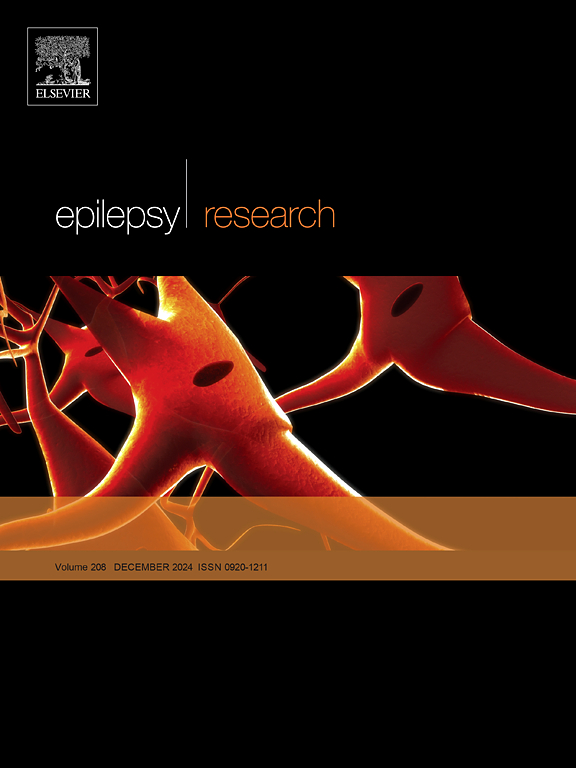Long-term musculoskeletal outcomes in pediatric hemispherotomy
IF 2
4区 医学
Q3 CLINICAL NEUROLOGY
引用次数: 0
Abstract
Objective
The purpose of this study is to describe long-term functional mobility and musculoskeletal interventions in a group of pediatric patients who underwent hemispherotomy and hemispherectomy (HS) for drug-resistant epilepsy.
Methods
We conducted a retrospective review of patients who underwent HS at UPMC Children’s Hospital of Pittsburgh from 1997 to 2023 with at least 1 year of follow-up. Gross Motor Function Classification System (GMFCS) levels and data on upper extremity function were collected pre-operatively and at 1-, 2-, 5-, 10-, and 15-years post-HS for each patient. Musculoskeletal interventions including use of orthotic devices, chemodenervation, and orthopedic surgery were also documented for each patient at follow-up timepoints.
Results
A total of 35 patients (51.4 % female) underwent HS at 4.26 ± 4.26 years old for drug-resistant epilepsy and presented for follow-up at 1 (n = 35), 2 (n = 29), 5 (n = 19), 10 (n = 15), and 15 (n = 13) years post-HS. All patients had post-operative hemiparesis with upper extremity functioning exhibiting the expected proximal-to-distal gradient in impairment. 20 patients (57 %) experienced no change in GMFCS levels throughout follow-up while 14 (40 %) showed improvement in GMFCS level. Use of orthotics at each timepoint ranged from 78 % to 100 % of the cohort. In total, 11 (34 %) patients underwent at least one round of chemodenervation and 11 (34 %) underwent at least one orthopedic surgical procedure.
Conclusions
Our study demonstrates that children who undergo HS experience minimal long-term impact on broad measures of functional mobility but may still require intervention for management of spasticity, muscle contractures, and bony deformities.
儿童半球切开术的长期肌肉骨骼预后
目的本研究的目的是描述一组接受半脑切开术和半脑切除术(HS)治疗耐药癫痫的儿科患者的长期功能活动和肌肉骨骼干预。方法回顾性分析1997年至2023年在匹兹堡UPMC儿童医院接受HS治疗的患者,随访至少1年。收集每位患者术前及hs后1年、2年、5年、10年和15年的大运动功能分类系统(GMFCS)水平和上肢功能数据。在随访时间点记录每位患者的肌肉骨骼干预措施,包括矫形器、化学神经支配和矫形手术的使用。ResultsA共有35例(51.4 %女)接受海关4.26 ± 4.26岁癫痫耐药和提出了后续1 (n = 35),2 (n = 29),5 (n = 19),10 (n = 15),15 (n = 13)年通过。所有患者术后偏瘫,上肢功能表现出预期的近端到远端梯度损伤。20例(57 %)患者在随访期间GMFCS水平无变化,14例(40 %)患者GMFCS水平有所改善。每个时间点矫形器的使用率从78% %到100% %不等。总共有11例(34% %)患者接受了至少一轮化学神经支配,11例(34% %)患者接受了至少一次骨科手术。我们的研究表明,接受HS的儿童对广泛的功能活动能力的长期影响很小,但可能仍然需要干预痉挛、肌肉挛缩和骨畸形的管理。
本文章由计算机程序翻译,如有差异,请以英文原文为准。
求助全文
约1分钟内获得全文
求助全文
来源期刊

Epilepsy Research
医学-临床神经学
CiteScore
0.10
自引率
4.50%
发文量
143
审稿时长
62 days
期刊介绍:
Epilepsy Research provides for publication of high quality articles in both basic and clinical epilepsy research, with a special emphasis on translational research that ultimately relates to epilepsy as a human condition. The journal is intended to provide a forum for reporting the best and most rigorous epilepsy research from all disciplines ranging from biophysics and molecular biology to epidemiological and psychosocial research. As such the journal will publish original papers relevant to epilepsy from any scientific discipline and also studies of a multidisciplinary nature. Clinical and experimental research papers adopting fresh conceptual approaches to the study of epilepsy and its treatment are encouraged. The overriding criteria for publication are novelty, significant clinical or experimental relevance, and interest to a multidisciplinary audience in the broad arena of epilepsy. Review articles focused on any topic of epilepsy research will also be considered, but only if they present an exceptionally clear synthesis of current knowledge and future directions of a research area, based on a critical assessment of the available data or on hypotheses that are likely to stimulate more critical thinking and further advances in an area of epilepsy research.
 求助内容:
求助内容: 应助结果提醒方式:
应助结果提醒方式:


